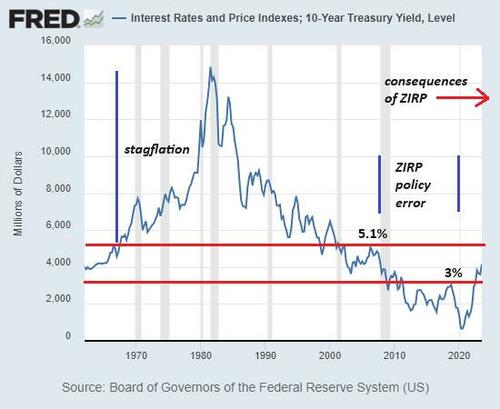High Interest Rates Are Healthy, Low Rates Are Poison
Authored by Charles Hugh Smith via OfTwoMinds blog,
The status quo has it backwards: low rates are now essential to prop up the wreckage left from previous doses of default and cascading losses.
The economy depends on two related drivers: low interest rates and asset bubbles. These two feed back into one another, as low rates / loose credit enables those marginal buyers who otherwise wouldn’t qualify to enter the market, generating demand pressure which boosts asset valuations, which then provide more collateral for additional borrowing.
This dynamic is what inflated Housing Bubble #1 in 2003-2007, as mortgage agencies (Fannie Mae, Freddie Mac), private-sector lenders and credit agencies all opened the spigots of loose lending standards and low interest rates to enable marginal buyers–roughly 5% of the entire market of homeowners–to buy homes.
At the other end of the spectrum, those with ready access to credit jumped into marginal development projects to cash in on the bubble inflating. This dynamic worked in a similar fashion: projects that would have been too risky when rates were high and credit was tight were now penciling out as opportunities to cash in on the bubble by selling unbuilt homes in marginal areas to marginal buyers seeking to pyramid their wealth castles of debt.
Since the first house they bought with a 3% down payment loan had soared in value, they could now borrow against that “wealth” / collateral to buy a second spec home, and as that rose in value (even if it wasn’t yet finished), they could leverage that gain into a third mortgage / spec house. The developers were minting money as buyers snapped up houses not yet even started.
This low-rates, loose credit bubble burst, as all credit-based bubbles do, with devastating consequences. The Phantom wealth of the bubble vanished, leaving giant craters of default and losses.
Low rates and loose credit are poison that tastes so good we can’t stop consuming more. Then the effects kick in, and the emergency measures–bailing out Too Big To Fail lenders and agencies–don’t restore the phantom wealth or a healthy economy. Rather, they make the economy dependent on financial fentanyl for its “growth.”
High interest rates and tight credit standards force consumers to discipline their financial habits to save money and pay down debt as the only means to increase their creditworthiness. The same discipline is imposed on big-time developers / investors: marginal projects no longer pencil out, and so risky gambles are set aside.
The economy prospers when marginal borrowers doomed to default are excluded and risky ventures doomed to fail are tabled. Low interest rates and loose credit inject default and catastrophic losses into the system, and as these defaults and losses ripple through the tightly bound financial system, they trigger other defaults and losses, forcing financial authorities to reward the losers with bailouts: the profits skimmed from risky lending and investments are private, but the losses fall on the taxpayers and the public.
IN effect, the big players in the casino can go ahead and gamble on high-risk bets, knowing the house will cover their losses. The individuals sucked into margin debt, pyramided debt and risky gambles will be wiped out–no bailout for you–while those that enabled the casino are saved from the consequences of their risky gambles.
The Federal Reserve moved Heaven and Earth to push interest rates near zero and open the credit spigots as the means to “grow the economy.” Depending on more poison to treat the previous poisoning is itself a risky gamble. As with real-world fentanyl, whether the dose of financial fentanyl is lethal or not is unknown until it’s too late.
High interest rates and tight credit are healthy, low rates and loose credit are sugar-high poison. The status quo has it backwards: low rates are now essential to prop up the wreckage left from previous doses of default and cascading losses.
* * *
Tyler Durden
Mon, 01/06/2025 – 19:15

